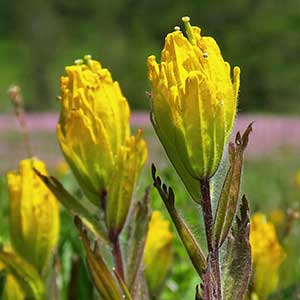Castilleja levisecta
Castilleja crista-galli
golden Indian paintbrush, golden paintbrush
cock's-comb paintbrush, mountainside Indian paintbrush
few to many, erect, ± decumbent or creeping at base, unbranched, sometimes branched, hairs spreading, medium length and long, soft, mixed with short stipitate-glandular ones.
few to several, erect or ascending, unbranched or branched, sometimes with short, leafy axillary shoots, hairy, sometimes glabrate proximally, hairs spreading to retrorse, medium length to long, soft, eglandular, often mixed distally with shorter stipitate-glandular ones.
green to purple or brown-tinged, linear-lanceolate proximally, oblong-ovate or -obovate distally, 0.8–5.2 cm, not fleshy, margins plane, distalmost sometimes ± wavy, involute, 3–7(–11)-lobed, apex obtuse;
lobes erect to ascending, linear to linear-spatulate, very short, toothlike, usually arising from distal 1/3 of blade, apex rounded.
green, linear to narrowly lanceolate, 2–8 cm, not fleshy, margins plane, involute, 0–5-lobed, apex acute;
lateral lobes spreading, linear, apex acuminate.
2.5–25 × 1–4 cm;
bracts bright yellow throughout, or proximally greenish, distally bright yellow, sometimes deep yellow-orange, especially with age, oblong, elliptic, or obtuse to ovate, (0–)5–9(–13)-lobed, sometimes wavy-margined;
lobes erect to ascending, oblong, short to medium length, arising above mid length, central lobe apex rounded, lateral ones rounded to acute.
3–6(–11) × 1.5–6.5 cm;
bracts proximally greenish, distally red, red-orange, or orange, sometimes yellow or dull salmon, narrowly to broadly lanceolate or oblong, 3–5-lobed;
lobes ascending-spreading, linear-lanceolate, long, arising below mid length, central lobe apex rounded to obtuse, lateral ones acute.
straight or slightly curved, 17–28 mm;
tube 12–15 mm;
beak exserted, adaxially green or greenish yellow, 6–8 mm;
abaxial lip yellow or greenish, reduced, not inflated, 2–3 mm, 25–33(–50)% as long as beak;
teeth ascending to erect, yellow, 0.5–1.5 mm.
straight, (25–)30–40(–45) mm;
tube 15–20 mm;
abaxial lip visible through front cleft, beak long-exserted from calyx;
beak adaxially green or yellow-green, 16–21 mm;
abaxial lip proximally white or yellow-green, distally green, reduced, usually visible in front cleft, 3 mm, 20% as long as beak;
teeth incurved to ascending, green, 1 mm.
distally yellow, 13–22 mm;
abaxial and adaxial clefts 4–9.5 mm, 30–40% of calyx length, deeper than laterals, lateral 2.5–4.5 mm, ca. 25% of calyx length;
lobes linear to narrowly oblong or narrowly lanceolate, apex obtuse, sometimes rounded to acute.
colored as bracts, (20–)25–35 mm;
abaxial and adaxial clefts (6–)10–17 mm, 50% of calyx length, deeper than laterals, lateral (1–)3–6(–10) mm, 35% of calyx length;
lobes slender, triangular, apex acute.
= 24.
= 96.
Castilleja levisecta
Castilleja crista-galli
Castilleja levisecta is listed as threatened in the United States and endangered in Canada, where it is extremely rare. Most of its grassland habitat has been altered by development in the Puget Trough, and there are historical stations in the metro areas of what are now Victoria, Portland, and Seattle. For several decades, C. levisecta was considered extirpated from Oregon. However, recent reintroduction programs in Oregon and Washington have been very successful at reestablishing this species at several sites in the Willamette Valley. The bright yellow inflorescences often gradually age to a golden yellow color, unique in the genus.
Castilleja levisecta is in the Center for Plant Conservation’s National Collection of Endangered Plants.
(Discussion copyrighted by Flora of North America; reprinted with permission.)
Castilleja crista-galli is found in the Rocky Mountains of southwestern Montana and northwestern Wyoming. The extent of its distribution into adjacent Idaho is unresolved, in part because it is frequently confused with either C. linariifolia or C. miniata. Castilleja crista-galli appears to be morphologically intermediate between them, leading to speculation that it might be an allopolyploid derivative. A DNA study (S. Matthews and M. Lavin 1998) showed little support for a hybrid origin. Castilleja crista-galli may be separated with some difficulty from the other two species by the presence of at least some short hairs on the stems and the frequently three- to five-parted leaves. Castilleja linariifolia and C. miniata both usually have subglabrous stems and entire leaves, sometimes three-parted distally, near the inflorescence.
(Discussion copyrighted by Flora of North America; reprinted with permission.)


